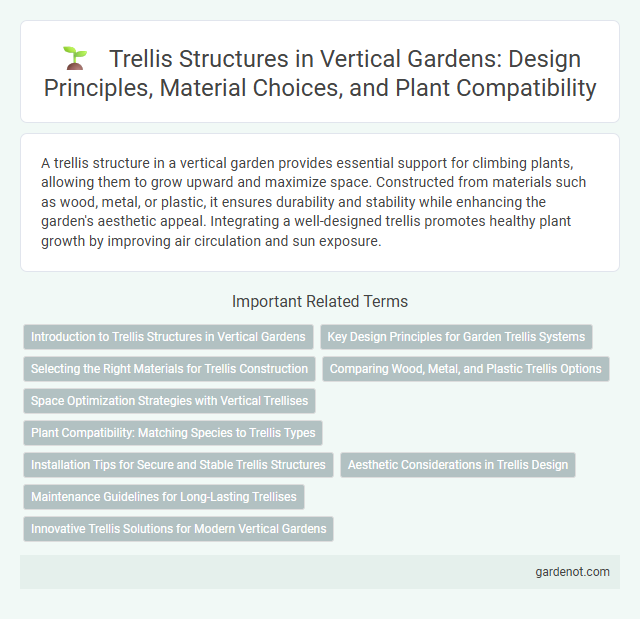A trellis structure in a vertical garden provides essential support for climbing plants, allowing them to grow upward and maximize space. Constructed from materials such as wood, metal, or plastic, it ensures durability and stability while enhancing the garden's aesthetic appeal. Integrating a well-designed trellis promotes healthy plant growth by improving air circulation and sun exposure.
Introduction to Trellis Structures in Vertical Gardens
Trellis structures in vertical gardens provide essential support for climbing plants, enabling efficient use of vertical space in urban and small-scale gardening. Constructed from materials such as wood, metal, or PVC, trellises promote healthy plant growth by improving air circulation and sunlight exposure. These frameworks enhance both aesthetics and functionality, making them a vital component for optimizing vertical garden designs.
Key Design Principles for Garden Trellis Systems
Garden trellis systems should prioritize sturdy materials such as cedar or metal for long-lasting support in vertical garden setups. Adequate spacing between trellis slats is essential to facilitate healthy plant growth and prevent overcrowding, while ensuring optimal sunlight exposure. Incorporating modular designs allows flexibility and easy expansion, enhancing both aesthetics and functionality in vertical garden installations.
Selecting the Right Materials for Trellis Construction
Selecting durable materials like cedar, redwood, or metal ensures a long-lasting trellis structure for vertical gardens, resisting weather and pests effectively. Opting for rot-resistant woods or powder-coated steel enhances structural integrity while supporting heavy climbing plants. Using UV-resistant and rust-proof coatings further protects the trellis, maintaining both functionality and aesthetics in varying outdoor conditions.
Comparing Wood, Metal, and Plastic Trellis Options
Wood trellis structures offer a natural aesthetic and are biodegradable but may require regular maintenance to prevent rot and insect damage. Metal trellises provide superior durability and resistance to weather conditions, often coated to prevent rust, making them suitable for long-term vertical gardens. Plastic trellises are lightweight, cost-effective, and resistant to moisture, though they might lack the strength and elegant appearance found in wood or metal options.
Space Optimization Strategies with Vertical Trellises
Vertical trellises maximize space utilization by allowing plants to grow upward rather than outward, ideal for small gardens and urban balconies. These structures support climbing plants such as vines, beans, and cucumbers, increasing crop yield per square foot while improving air circulation and sunlight exposure. Incorporating adjustable or modular trellises enhances flexibility in plant arrangement, optimizing vertical garden productivity and aesthetic appeal.
Plant Compatibility: Matching Species to Trellis Types
Selecting the right trellis structure is crucial for vertical gardens to ensure optimal plant growth and support. Vining plants like peas and cucumbers thrive on sturdy, wire mesh trellises, while climbing roses and clematis prefer wooden lattice frameworks. Lightweight plants such as ivy and morning glory are best suited for delicate string or bamboo trellises that provide flexible support without restricting growth.
Installation Tips for Secure and Stable Trellis Structures
Ensure vertical garden trellis structures are anchored deeply into the soil using galvanized steel or treated wood for enhanced durability and rust resistance. Use heavy-duty brackets and screws designed for outdoor use to firmly attach the trellis to walls or posts, preventing wobbling under plant weight and weather conditions. Regularly inspect and tighten all connections, especially after storms, to maintain stability and support vigorous plant growth.
Aesthetic Considerations in Trellis Design
Trellis design in vertical gardens significantly enhances aesthetic appeal by incorporating materials such as natural wood, metal, or bamboo that complement surrounding architecture and greenery. Strategic patterns and shapes, including lattice or geometric designs, create visual interest and allow for creative plant arrangement, maximizing both beauty and space. Color finishes and illumination options further personalize the trellis, turning vertical gardens into striking focal points in urban and residential environments.
Maintenance Guidelines for Long-Lasting Trellises
Trellis structures in vertical gardens require regular inspection to ensure stability and prevent damage from weather or plant growth. Cleaning the trellis with mild solutions and removing debris helps avoid mold and decay, extending its lifespan. Applying protective coatings and checking for loose connections maintain the structural integrity essential for supporting climbing plants.
Innovative Trellis Solutions for Modern Vertical Gardens
Innovative trellis solutions for modern vertical gardens incorporate lightweight, durable materials such as powder-coated aluminum and bamboo composites that enhance structural integrity while promoting plant health. Modular trellis designs with adjustable panels optimize space efficiency and allow for customizable growth patterns suited to diverse plant species. Integration of smart irrigation systems within trellis frameworks ensures precise water delivery, reducing waste and supporting sustainable urban gardening practices.
Trellis structure Infographic

 gardenot.com
gardenot.com